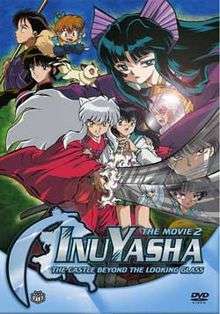Inuyasha the Movie: The Castle Beyond the Looking Glass
| Inuyasha the Movie: The Castle Beyond the Looking Glass | |
|---|---|
 North American DVD cover art | |
| Directed by | Toshiya Shinohara |
| Produced by |
|
| Screenplay by | Katsuyuki Sumisawa |
| Based on |
Inuyasha by Rumiko Takahashi |
| Music by | Kaoru Wada |
| Cinematography | Hirofumi Yagi |
| Edited by | Shigeyuki Yamamori |
Production company | |
| Distributed by | Toho |
Release dates |
|
Running time | 99 minutes |
| Country | Japan |
| Language | Japanese |
| Budget | US$3.2 million |
| Box office | $7,506,630[1] |
Inuyasha the Movie: The Castle Beyond the Looking Glass (映画犬夜叉 鏡の中の夢幻城 Eiga Inuyasha: Kagami no Naka no Mugenjō lit. Inuyasha The Movie: Phantom Castle in the Mirror) is the second film of the Inuyasha series. It was released in Japan on December 21, 2002 (between episodes 95 & 96), and in the United States on December 28, 2004. In this film, the character designs are virtually identical to the Rumiko Takahashi versions from the original manga (rather than using the Yoshihito Hishinuma designs from the TV anime).
Plot
After defeating Naraku, they subsequently split up, leaving InuYasha, Kagome and Shippo searching for the remainder of the Shikon Jewel shards without Miroku or Sango. Kagura and Kanna, the two surviving incarnations of Naraku are restless now that Naraku is dead. They find a mirror in a shrine and awaken Kaguya, Princess of the Heavens. In exchange for freeing her, Kaguya promises to grant Kagura her eternal freedom. The two set out to recover five items that will free Kaguya from her mirror, leading them to cross paths once again with InuYasha and his friends. Kaguya, desiring to stop time, kidnaps Kagome who is able to put up a barrier against her spells. The remainder of the group reunite in Kaguya's realm of mirrors in order to retrieve Kagome. Kaguya, intending to enslave InuYasha, attempts to transform him in to a full-fledged demon. The spell is broken by Kagome, who admits her love for InuYasha for the first time in order to stop the transformation. Naraku reappears on Kohaku's back, revealing that he had purposely faked his death to absorb Kaguya. Naraku, unable to fight on equal terms, then escapes with Kohaku, Kagura and Kanna. Kagome then combines her power with that of Miroku as she launches a piece of his staff in the form of an arrow and destroys Kaguya's mirror. InuYasha then destroys Kaguya's physical form. Kaguya appears in a gas-like form and tries to take control of Kagome's body but ends up being sucked into Miroku's wind tunnel. They escape back to the normal world through Kaguya's mirror as her palace collapses. With things returned to normal, an embarrassed InuYasha and Kagome resume denying their feelings for each other, refusing to discuss Kagome's confession in the mirror realm.
Cast and Credits
Cast
- InuYasha - Kappei Yamaguchi/Richard Ian Cox
- Kagome Higurashi - Satsuki Yukino/Moneca Stori
- Miroku - Koji Tsujitani/Kirby Morrow
- Sango - Hōko Kuwashima/Kelly Sheridan
- Shippo - Kumiko Watanabe/Jillian Michaels
- Kagura - Izumi Ōgami/Janyse Jaud
- Myōga - Kenichi Ogata/Paul Dobson
- Naraku - Toshiyuki Morikawa/Paul Dobson
- Sota Higurashi - Akiko Nakagawa/Saffron Henderson
- Kagome and Sota's Grandfather - Katsumi Suzuki/French Tickner
- Kagome and Sota's Mother - Asako Dodo/Cathy Weseluck
- Kaede - Hisako Kyoda/Pam Hyatt
- Kanna - Yukana/Janyse Jaud
- Kikyo - Noriko Hidaka/Willow Johnson
- Hachi - Toshihiko Nakajima/Terry Klassen
- Kohaku - Akiko Yajima/Danny McKinnon
- Kaguya - Mieko Harada/Nicole Oliver
- Mushin - Yuzuru Fujimoto/Alec Willows
- Hojo - Yuji Ueda/Matt Smith
- Ayumi - Nami Okamoto/Cathy Weseluck
- Eri - Yuki Masuda/Saffron Henderson
- Yuka - Kaori Shimizu/Jillian Michaels
Credits
- Directior
- Toshiya Shinohara
- Script
- Katsuyuki Sumisawa
- Music
- Kaoru Wada
- Original Concept
- Rumiko Takahashi
- Art Director
- Tsutomu Ishigaki
- Director of Photography
- Hirofumi Yagi
- Producers
- Masuo Ueda, Michihiko Suwa, Mikihiro Iwata
- Theme Song
- "Yura Yura" (ゆらゆら Wavering)
- Lyrics by: Kaori Mochida
- Composed by: Kunio Tako
- Arranged by: Yasuo Otani, Masafumi Nakao, and Ichiro Ito
- Performed by: Every Little Thing
- Insertion Song
- "Ai no Uta" (愛の謳 lit. Song of Love)
- Lyrics by: Kaori Mochida
- Composed by: Kunio Tako
- Arranged by: Akira Murata
- Performed by: Every Little Thing
References
External links
- Inuyasha the Movie: The Castle Beyond the Looking Glass (anime) at Anime News Network's encyclopedia
- Inuyasha the Movie: The Castle Beyond the Looking Glass at the Internet Movie Database